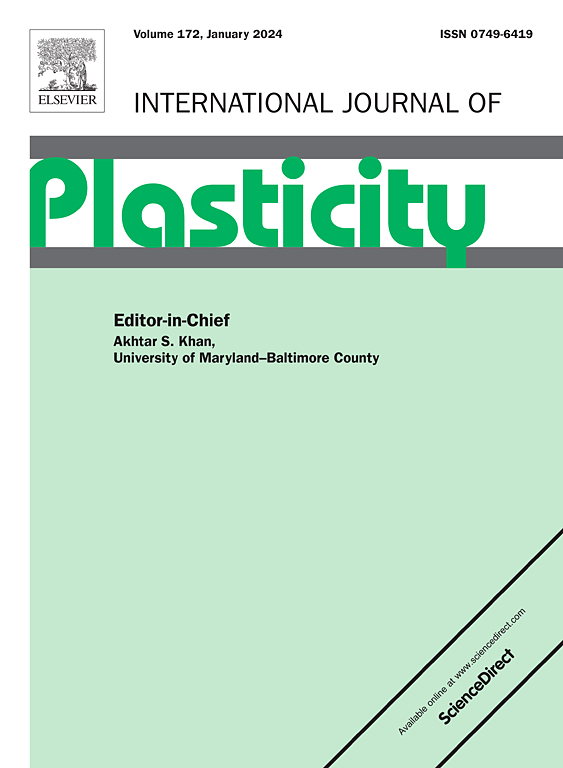Tensorial interaction model for the effect of short-range order on single crystalline medium entropy alloys
IF 9.4
1区 材料科学
Q1 ENGINEERING, MECHANICAL
引用次数: 0
Abstract
In order to help comprehend the influence of short-range order (SRO) structures on both the mechanical property and microstructural evolution of single crystalline medium entropy alloys (MEAs), a physical mechanism-based crystal plasticity theory is developed in this work, which covers the deformation mechanisms of dislocation-SRO interaction, network dislocation interaction, dislocation-twin boundary interaction, twinning deformation and solid solute strengthening. Thereinto, a tensorial interaction model is proposed to effectively characterize the spatial interaction between SROs on the characteristic planes and dislocations on the slip planes, which can not only address the increase of yield stress related to the impediment of slip dislocations by SROs, but also capture the phenomenon of decreasing flow stress after the yield point due to the destruction of SRO structures. Moreover, twinning deformation has been additionally taken into account by considering the complex hardening behavior related to both co-planar and non-co-planar twinning. To help validate the proposed constitutive equations, the stress-strain relations of single crystalline CrCoNi under three different loading directions are compared between the experimental data and theoretical results. A good agreement is achieved that can help verify the proposed theoretical model and facilitate the comprehension of the underlying deformation mechanisms.
单晶介质熵合金短程有序影响的张量相互作用模型
为了更好地理解短程有序结构(SRO)对单晶介质熵合金(MEAs)力学性能和微观组织演变的影响,本文建立了基于物理机制的晶体塑性理论,包括位错-SRO相互作用、网络位错相互作用、位错-孪晶界相互作用、孪晶界变形和固体溶质强化的变形机制。其中,提出了一种张拉相互作用模型,有效表征特征面上的SRO与滑移面上的位错之间的空间相互作用,既能解决SRO阻碍滑移位错导致屈服应力增加的问题,又能捕捉到SRO结构破坏导致屈服点后流动应力下降的现象。此外,通过考虑与共面和非共面孪晶相关的复杂硬化行为,还考虑了孪晶变形。为了验证本文提出的本构方程,比较了三种不同加载方向下单晶CrCoNi的应力-应变关系。得到的结果很好地吻合,这有助于验证所提出的理论模型,并有助于理解潜在的变形机制。
本文章由计算机程序翻译,如有差异,请以英文原文为准。
求助全文
约1分钟内获得全文
求助全文
来源期刊

International Journal of Plasticity
工程技术-材料科学:综合
CiteScore
15.30
自引率
26.50%
发文量
256
审稿时长
46 days
期刊介绍:
International Journal of Plasticity aims to present original research encompassing all facets of plastic deformation, damage, and fracture behavior in both isotropic and anisotropic solids. This includes exploring the thermodynamics of plasticity and fracture, continuum theory, and macroscopic as well as microscopic phenomena.
Topics of interest span the plastic behavior of single crystals and polycrystalline metals, ceramics, rocks, soils, composites, nanocrystalline and microelectronics materials, shape memory alloys, ferroelectric ceramics, thin films, and polymers. Additionally, the journal covers plasticity aspects of failure and fracture mechanics. Contributions involving significant experimental, numerical, or theoretical advancements that enhance the understanding of the plastic behavior of solids are particularly valued. Papers addressing the modeling of finite nonlinear elastic deformation, bearing similarities to the modeling of plastic deformation, are also welcomed.
 求助内容:
求助内容: 应助结果提醒方式:
应助结果提醒方式:


